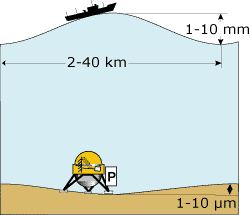What is Seafloor Compliance?
Seafloor compliance is a measure of how much the seafloor moves under pressure forcing from ocean waves. The softer the ground is, the more the seafloor will move. By measuring this motion as a function of the forcing wavelength, we can determine the subsurface structure as a function of depth. Compliance measurements are most sensitive to the subsurface shear modulus. Low shear modulus bodies such as fluid-bearing sediments, hydrothermal circulation systems or melt bodies create a peak in the compliance that can be analyzed to determine the body's depth, size, and shear modulus.

Cartoon representation of a compliance measurement (not to scale!), with typical signal wavelengths and amplitudes.
We measure compliance in the period band from 10 seconds to 20 minutes, where the pressure signal comes from ocean surface gravity waves known as infragravity waves. These waves have a very simple dispersion relation, which allows us to calculate their wavelength from the frequency and the water depth. The infragravity waves we measure are from a few hundred meters to tens of kilometers long and a few millimeters tall. Underneath these waves, the seafloor moves a few micrometers vertically. We measure the pressure and displacement simultaneously using sensitive broadband seismometers and differential pressure gauges that we deploy to the seafloor for at least a day and a half at a time. We then throw out bad data caused by earthquakes and fish bumps and statistically analyze the remaining data to minimize the noise. During a typical 20-day cruise we can deploy one instrument at 10 different sites. Using several instruments and combining the measurements, we can create a 2D or 3D model of the subsurface shear modulus.
Compliance measurements have been used to study the melt structure beneath mid-ocean ridges and the porosity and physical properties of coastal sediments, and we are preparing an experiment to study sediments beneath basalt flows. Compliance measurements can be used to study any subsurface system where fluids play an important role, such as hydrothermal circulation networks, intraplate volcanoes, and subduction zones. An important future application of compliance measurements is continuous monitoring of time-variant fluid systems (such as the eruptive cycle of magma chambers or the change in a petroleum reservoir during drilling). Since the ocean waves are always "on", continous measurements should give a film of fluid movements that can be correlated to surface events. If the instrument is connected to the surface by a cable, these effects could be measured in near-real time.